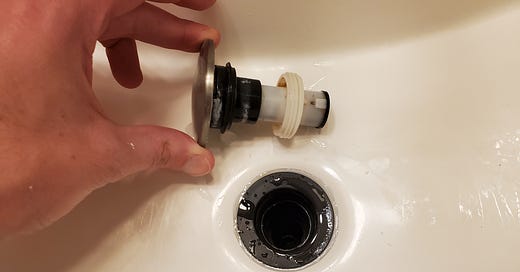You most likely know what this is:
You may or may not know how to remove it. It’s easier to remove than reinstall. You have to undo the little metal clip that connects the rod that controls the stopper with a rod that attaches to the bottom of this piece. Then you have to unscrew a metal piece on the back of the sink pipe to disconnect this piece from the rod that links with the stopper rod.
Getting it out is tricky. Getting it back in is tricky. And redoing the metal clip? Ditto. This whole procedure will generally result in some water leaking, so get a rag or a plastic tray ready underneath the pipe.
This whole drain stopper assembly is excellent at catching hair and debris and clogging up the sink, which theoretically means it helps keep that stuff out of the pipe, and gives you an easy way to clean it. But then you have to do the above.
Contrast that with this:
It’s a screw-in drain assembly in the bathroom sink in our old place that goes with the faucet (a Pfister). I’m not sure if every sink can take one of these, or whether the sink pairs with the faucet specifically. There seem to be cheap universal versions of this type of drain out there, but they have poor online reviews. I’ve only ever seen this in my sink. (My parents had an aftermarket drain for their bathtub kind of like this, and it never formed a proper seal, so the tub would slowly leak the whole time you were in it. This one does not have that flaw.)
You push it down to make the sink hold water. You push it again to release the suction. You simply screw it in or out to remove it and clean it. It’s so simple that I never have to think about it, and the sink has never clogged up, at least in the drain stopper part of things. There’s no stopper rod to bend, no metal clip to fall off, fewer moving parts and fewer things to corrode or freeze up.
Why don’t all sinks/faucets use this? If you happen to have any plumbing knowledge, I’m very curious. It seems like a vast improvement to me, something that functions better and simplifies the overall design. I don’t know what the drawbacks of this design might be, but I’m sure there are some.
I might have another faucet/plumbing post coming up—new house, new problems—but there’s something beyond plumbing here, which I’ve touched on a lot recently. Faced with a clogged up drain and an old-fashioned drain assembly, you should probably learn how to take apart the drain. But that doesn’t necessarily mean there’s anything virtuous or noble about struggling with that old design.
The newer style is good. It’s an improvement. Improvements are good. Tools that do their job well are good. I’ve been thinking a lot lately about how so much of what gets characterized as “entitlement” is really asking for the right tool for the job. If you don’t have it, you do what you can. But you still demand it.
As far as my big issue goes, zoning reform and a functional housing market are tools, not entitlements. And, since this isn’t a housing piece, a simple, easy-to-clean drain is a great tool too.
Related Reading:
Asking For the Right Tool Isn’t Asking For a Handout
Thank you for reading! Please consider upgrading to a paid subscription to help support this newsletter. You’ll get a weekly subscribers-only post, plus full access to the archive: over 400 posts and growing. And you’ll help ensure more material like this!






I think part of the reason these drains never get improved is because the "better" versions are all patented and manufacturer specific (they're also harder to find repair parts for because they're proprietary one offs instead of a "universal" design). American Standard had a really great take on this a few years ago, but I'm not sure if it's even still being made: https://www.youtube.com/watch?v=2vgBNw0xnYA
One other tip- get yourself one of these plastic drain clearing tools. You'll never have to disassemble the pop up again! It just slides past the drain plug and clears out the hair and other gunk: https://www.homedepot.com/p/THEWORKS-Drain-Cleaning-Tool-2-pack-PL171204/306535939